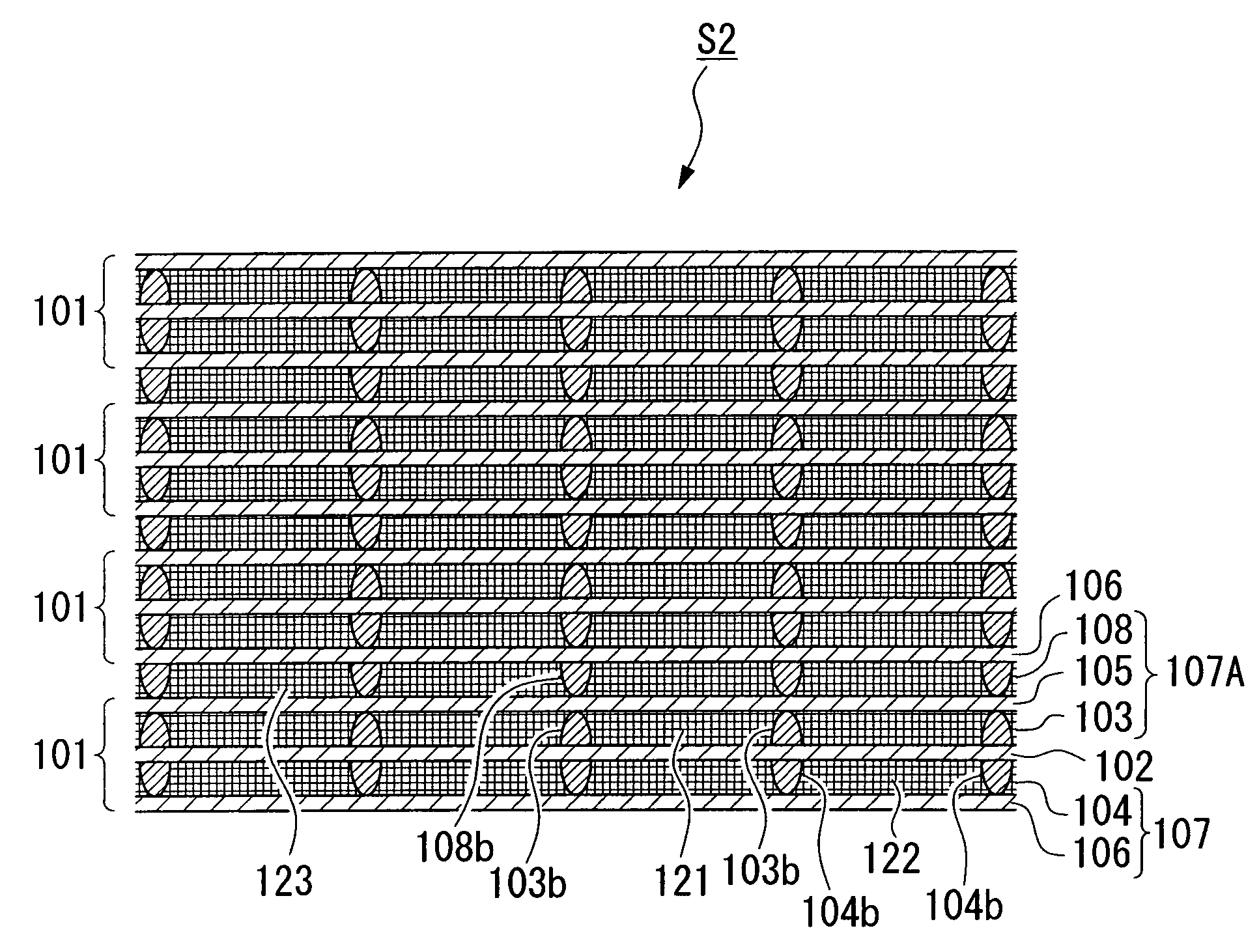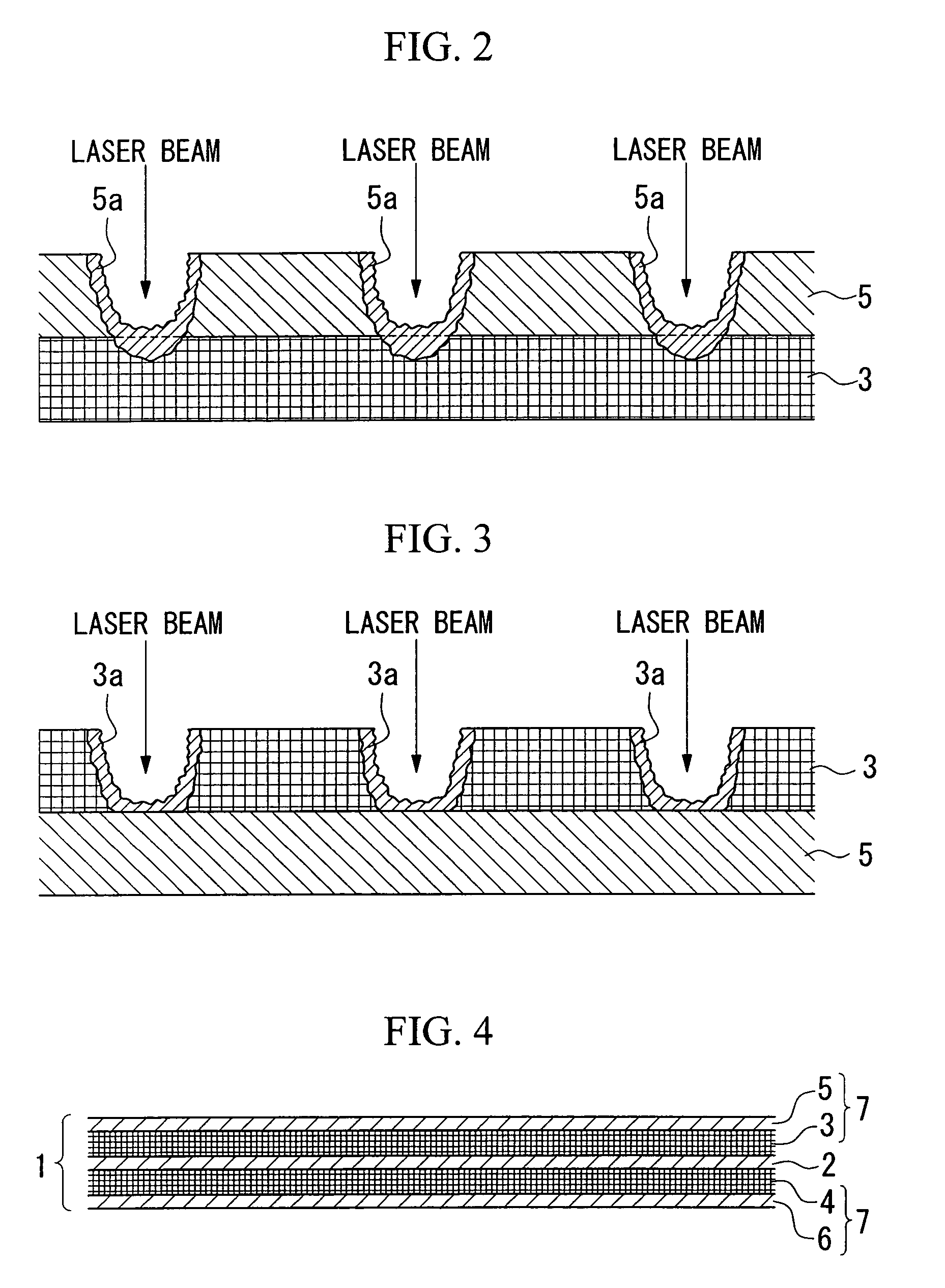Fuel cell separator assembly with diffusion layer, manufacturing method therefor, fuel cell unit, and fuel cell stack
a technology of separators and diffusion layers, which is applied in the direction of cell components, final product manufacturing, sustainable manufacturing/processing, etc., can solve the problems of poor assembling efficiency, difficult to handle the diffusion layer, and too many items being managed, and achieves high performan
- Summary
- Abstract
- Description
- Claims
- Application Information
AI Technical Summary
Benefits of technology
Problems solved by technology
Method used
Image
Examples
first embodiment
[0069]Through this process, a portion of the melted metal Sa created by locally melting the anode side separator 5 penetrates into the anode side diffusion layer 3 made of a porous metal body. After penetration, the irradiation by the laser beam is terminated, and the anode side separator 5 is allowed to cool naturally so that the melted metal held in the anode side separator 5 and the melted metal penetrated into the anode side diffusion layer 3 are solidified. As a result, the anode side diffusion layer 3 and the anode side separator 5 are connected (i.e., spot-welded) to each other at some portions. The anode side diffusion layer 3 and the anode side separator 5 are unified by making a number of spot-welded portions in the regions where the anode side diffusion layer 3 has surface contact with the anode side separator 5. The spot-welding process is employed in this first embodiment in order to increase productivity; however, the present invention is not limited to this, and a sea...
fourth embodiment
[0082]FIG. 5 is a longitudinal cross-sectional view of a fuel cell stack S1 according to the present invention. The fuel cell stack S1 includes a number of fuel cell units 101 which are stacked with each other.
[0083]The fuel cell unit 101 includes a membrane electrode assembly 102 having a solid polymer electrolyte membrane and anode and cathode electrodes that together sandwich the solid polymer electrolyte membrane, an anode side diffusion layer 103 and a cathode side diffusion layer 104 respectively disposed outside of the membrane electrode assembly 102, an anode side separator 105 disposed outside of the anode diffusion layer 103, and a cathode side separator 106 disposed outside of the cathode diffusion layer 104.
[0084]The anode side diffusion layer 103 and the anode side separator 105 have been welded together by laser-welding to form a separator assembly 107 with a diffusion layer, and cathode side diffusion layer 104 and the cathode side separator 106 have been welded toget...
fifth embodiment
[0092]As a fifth embodiment, after laser welding and forming of the flow passage partition 103b, or simultaneously with laser welding and forming of the flow passage partition 103b, the groove 103a may be filled with a padding 103c by making a melted metal flow into the groove 103a, as shown in FIG. 7.
[0093]Whether the flow passage partitions 103b should be formed in a shape having a number of spots, or in a straight shape is determined depending on the desired configuration of the flow passages. For example, as shown in FIG. 8, a number of straight-shaped flow passage partitions 103b, which are parallel to each other, may be made so as to form a fuel flow passage 121 having a zigzag shape (a sixth embodiment). Moreover, as shown in FIG. 9, straight-shaped flow passage partitions 103b may be disposed at random so as to form a fuel flow passage 121 between the flow passage partitions 103b (a seventh embodiment). Furthermore, as shown in FIG. 10, a number of spot-shaped flow passage p...
PUM
| Property | Measurement | Unit |
|---|---|---|
| Thickness | aaaaa | aaaaa |
Abstract
Description
Claims
Application Information
 Login to View More
Login to View More - R&D
- Intellectual Property
- Life Sciences
- Materials
- Tech Scout
- Unparalleled Data Quality
- Higher Quality Content
- 60% Fewer Hallucinations
Browse by: Latest US Patents, China's latest patents, Technical Efficacy Thesaurus, Application Domain, Technology Topic, Popular Technical Reports.
© 2025 PatSnap. All rights reserved.Legal|Privacy policy|Modern Slavery Act Transparency Statement|Sitemap|About US| Contact US: help@patsnap.com



